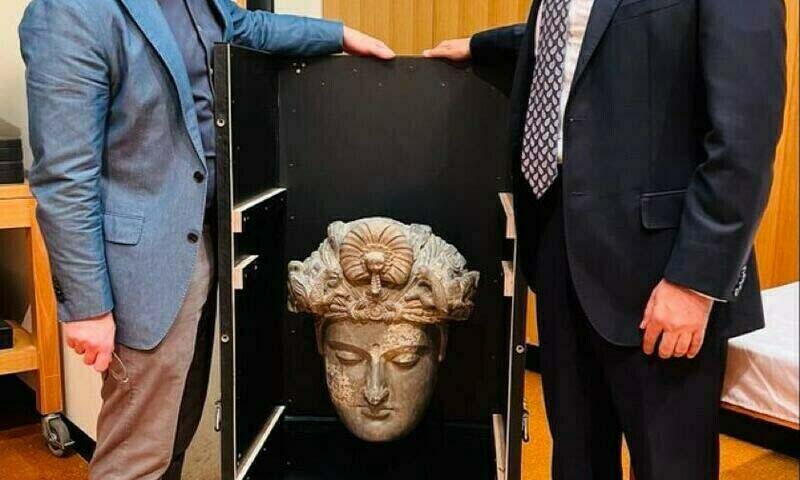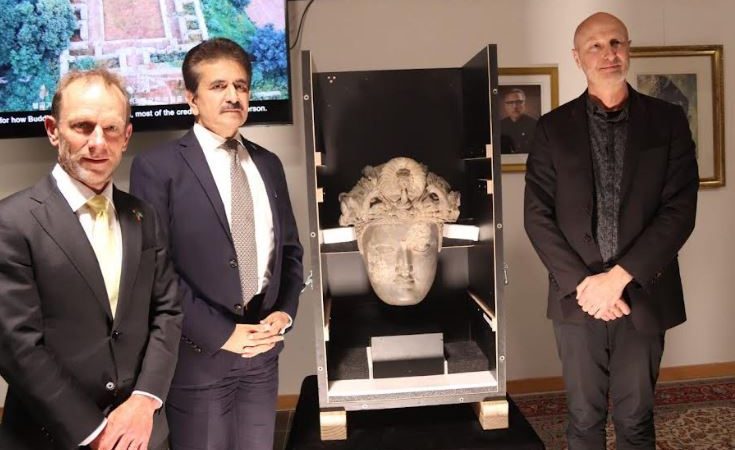Indian criminal smuggled the head of the Bodhisattva, worth half a million dollars, out of Pakistan and sold it to Canberra gallery
Australia returned on Monday an ancient Bodhisattva statue of the Gandhara art to Pakistan following an exhibition at the National Gallery in Canberra.
It was handed over to Pakistan’s High Commissioner for Australia Zahid Hafeez Chaudhri.
The artefact is believed to date back to the third and fourth century, It was acquired by the Australian gallery in 2006 at a staggering price of $275,000. It is now believed to be worth $500,000.
The Australian National Gallery had purchased the sculpture from an Indian, New York-based private art collector, Subash Chandra Kapoor, according to Pakistan’s High Commissioner for Australia.
“It was later discovered that Chandra Kapoor had been running an illegal art business,” High Commissioner Zahid Hafeez Chaudhri had told..
The high commissioner emphasised that criminal charges against Subash Chandra Kapoor must be used to expose and prosecute international crime syndicates dealing in historical works of art.

Australia returns stolen Gandharan sculpture to Pakistan.
He particularly acknowledged the Provenance Research Project of the National Gallery of Australia and thanked its entire team for making the return of the historical work of art to Pakistan possible.
He also highlighted the rich civilizational heritage of Pakistan which is millennia old. He invited the guests to visit and explore Pakistan to experience its diverse culture, rich heritage, beautiful landscape, wonderful cuisine, and the hospitality of Pakistani people.
Subash Chandra Kapoor: A History of Smuggling
The accused is currently under trial for the smuggling of the Gandharan piece in both India and New York. However, this isn’t the first time he has faced charges for his smuggling business.
Idol thief Subash Chandra Kapoor
In 2012, Chandra Kapoor was charged with the theft of 18 idols from the Sri Varadaraja Perumal Temple in India. Similarly, in 2015, he was charged with smuggling 28 idols of Hindu deities.
In the same year, New York security officers seized 80% of the idols displayed in his “Art of the Past” gallery.
The Head of Bodhisattva
The sculpture originated from Gandhara, which was a Buddhist region between the first and seventh centuries. The region is now part of modern-day northwestern Pakistan.
According to the high commissioner, the Head of the Bodhisattva dates back to the third or fourth century. Since the sculpture has religious significance for Buddhists, relevant people have been invited to the exhibition on August 22.
“Ambassadors of Buddhist countries and Buddhist monks have been invited to attend the exhibition, along with Australian people,” the high commissioner said. “It will essentially be a handing-over ceremony.”
The sculpture is just one of the many art pieces belonging to the Gandharan art tradition. These artefacts were first discovered in the nineteenth century, during an excavation project by the British. Dishes and coins were also discovered during the procedure.
Gandharan Sculpture
The materials used for the creation of Gandharan sculptures were green phyllite and grey-blue mica schists in the first two centuries. However, following the third century, stucco was increasingly used to create these sculptures. The Head of Bodhisattva is also created with stucco.
There is an extensive collection of Gandharan art in the Lahore Museum, while around 30,000 rare Gandhara antiques are displayed in the Peshawar Museum.
Hey! My name is Mahnoor and I joined Rangeinn as the content & News Writer. Currently, I’m doing my Bachelors in International Relations.







